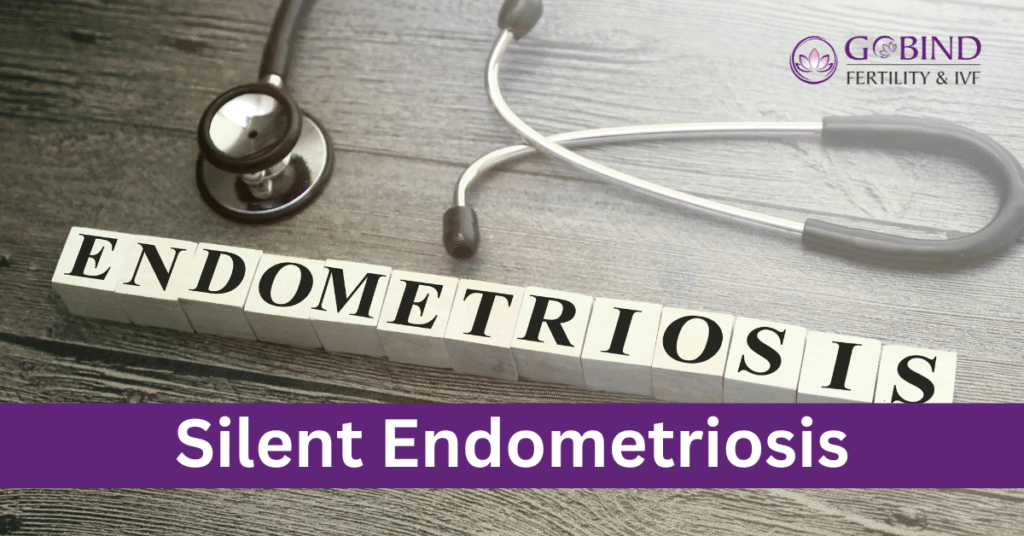Silent Endometriosis: The Hidden Cause of ‘Unexplained Infertility’

When a couple faces trouble conceiving without any apparent medical cause, the diagnosis often falls under the vague term “Unexplained Infertility”. But behind this mystery lies a condition that silently affects thousands of women—silent endometriosis. Unlike classic endometriosis, which causes painful periods, pelvic pain, or painful intercourse, silent endometriosis often presents with no obvious symptoms, making it extremely difficult to detect. Yet, it may significantly impact fertility and the ability to conceive naturally.
What is Silent Endometriosis?
Endometriosis is a condition where the tissue similar to the lining of the uterus (endometrium) grows outside the uterus, such as on the ovaries, fallopian tubes, pelvic lining, and sometimes even beyond the pelvic area. These misplaced tissues respond to hormonal changes during the menstrual cycle and bleed, just like the endometrium. However, since the blood has nowhere to go, it causes inflammation, scar tissue formation, adhesions, and eventually damage to reproductive organs.
In silent endometriosis, these lesions and abnormalities exist, but the woman experiences little to no symptoms, especially no significant pelvic pain or menstrual irregularities. This asymptomatic nature makes it a hidden cause of infertility, often only discovered during diagnostic laparoscopy or IVF treatment.
How Does Silent Endometriosis Affect Fertility?
Even without symptoms, silent endometriosis can:
- Disrupt ovarian function
- Alter egg quality
- Block or damage the fallopian tubes
- Cause chronic inflammation in the pelvic environment
- Negatively impact embryo implantation
These effects can hinder natural conception, reduce the success rates of intrauterine insemination (IUI), and even affect in vitro fertilisation (IVF) outcomes.
Why Is It Called the ‘Silent’ Infertility Culprit?
Silent endometriosis often
- Evades detection in standard ultrasounds or routine fertility tests
- It isn’t visible in blood work or hormonal evaluations
- Lacks hallmark symptoms like pelvic pain, painful periods, or dyspareunia (painful intercourse)
- It is frequently overlooked by general gynaecologists
As a result, many women are misdiagnosed with unexplained infertility and undergo years of ineffective fertility treatments without addressing the root cause.
Who Is at Risk of Silent Endometriosis?
Silent endometriosis can affect:
- Women in their 20s to late 30s
- Women with normal menstrual cycles
- Women with a family history of endometriosis
- Women undergoing multiple failed fertility treatments
- Those who’ve had ovarian cysts or pelvic infections in the past
Even fit, healthy women with no pelvic complaints may unknowingly carry the condition.
Diagnosis: The Need for High Clinical Suspicion
Silent endometriosis is notoriously difficult to diagnose without visual confirmation. The following tools may help:
1. Transvaginal Ultrasound
Although often used, it may not detect deep endometriosis or subtle pelvic adhesions.
2. MRI Pelvis
It can detect certain forms of endometriosis, like deep infiltrating endometriosis, but it isn’t 100% conclusive.
3. Laparoscopy (Gold Standard)
A minimally invasive surgery where a camera is inserted into the pelvic cavity. It allows direct visualisation and removal/biopsy of endometrial lesions. Many cases of silent endometriosis are only diagnosed during diagnostic laparoscopy when all other tests come back normal.
Treatment Options for Silent Endometriosis in Infertile Women
1. Laparoscopic Excision Surgery
This is both diagnostic and therapeutic. Removing the endometrial implants improves the chances of spontaneous conception and enhances the success rates of fertility treatments.
2. Fertility Treatment Post-Surgery
- IUI (Intrauterine Insemination): May be recommended after surgery in mild cases.
- IVF: In moderate to severe cases, IVF is preferred. Studies show higher IVF success rates after surgical management of endometriosis.
3. Medical Management
Hormonal therapy like GnRH agonists may be prescribed post-surgery, but is not suitable for women actively trying to conceive.
Why Awareness of Silent Endometriosis is Crucial for Fertility Specialists
Fertility specialists and gynaecologists should always consider silent endometriosis in cases of:
- Unexplained infertility
- Repeated IUI or IVF failures
- Women with subtle signs like fatigue, back pain, or minor digestive issues
- Presence of ovarian cysts, especially endometriomas (chocolate cysts)
Raising awareness about this silent enemy can save couples years of frustration and financial burden by guiding them toward targeted, effective treatment.
Silent Endometriosis and IVF: What’s the Connection?
IVF bypasses the fallopian tubes and is often successful in many infertility cases. However, in women with silent endometriosis:
- The egg quality may be compromised
- Embryo implantation rates may be lower
- Higher risk of IVF failure or early miscarriage
Hence, pre-treatment of endometriosis—surgical or medical—can improve IVF outcomes significantly.
Silent endometriosis is real, underdiagnosed, and a major contributor to unexplained infertility.
If you are:
- Struggling to conceive for over a year
- Have normal test reports
- Have undergone failed IUI/IVF cycles
- Have a family history of endometriosis or unexplained pain
Then talk to your fertility specialist about diagnostic laparoscopy or evaluation for silent endometriosis.
Conclusion
Silent endometriosis may be silent, but its impact on a woman’s reproductive health is profound. For couples stuck in the confusing cycle of unexplained infertility, identifying and treating this hidden condition could be the key to parenthood. Early detection, timely surgical intervention, and personalised fertility treatment can transform lives and bring hope to countless couples dreaming of a family.
